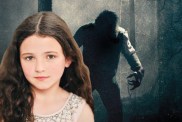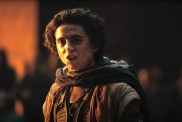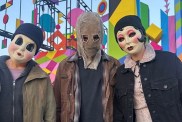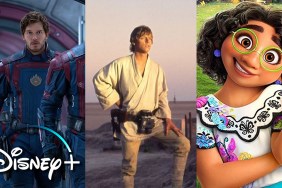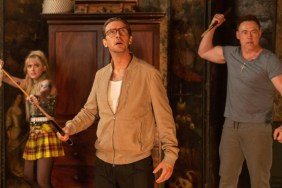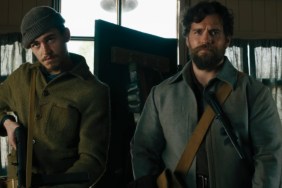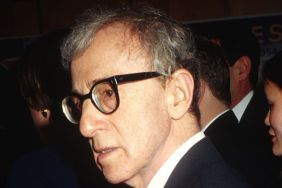
Out this week is Nightlight, a curious new entry in the seemingly endless wave of found footage horror. Curious because co-writers and co-directors Scott Beck and Bryan Woods clearly have something more on their mind than the lo-fi disarray of their more bland brethren, even if the film is a handheld, one-night jaunt through the forest. Like the recent Final Prayer (aka The Borderlands), the aesthetic feels less a capitalization on trend than a cinematic choice. After all, the point of view is less a camera than it is a flashlight. Here, the directors bring the spookiness of an urban legend and urgency of adolescent lives together through a unifying object.
In the film, a group of kids journey into the mysterious Covington Forest for an evening of flashlight games and ghost stories. But their plans go awry when the friends awaken a demonic presence, an unseen evil.
This guiding light in a forest that attracts teenage games and death, be it purposeful or mysterious, ends up shining on spooky stuff; hidden faces, living nature and even midst utter chaos, manages to catch the harsher violence. Shock Till You Drop spoke with Beck and Woods about their ambition for a teen-oriented, found footage horror movie, despite the worlds generally unfavorable views of exactly that
Shock Till You Drop: Nightlight really captures a controlled chaos, things that feel like complicated setups and blocking.
Scott Beck: Making Nightlight was a huge challenge. It was very much like choreographing a play, because we did shoot a lot of one takes and we had a lot of stunts, whether its going off a cliff, going in a creek, or going underneath a train. In many ways, it was reinventing how Bryan and I have shot films in the past.
Bryan Woods: Some of our favorite filmmakers are people like David Fincher or Alfred Hitchcock or Roman Polanski, directors who are very deliberate with their choices, with the camera and choreography. So, thats something that we take to heart any time that we make a movie. We certainly are meticulous storyboard-ers. Even in a film that does sort of exist in this found footage space, we still wanted to have a very controlled lookcontrolled chaos, well said.
Beck: I think there was certainly a fatigue that Bryan and I feel, even though were fans of Blair Witch and Cloverfield and Chronicle. I think with Nightlight, what we really wanted to make sure we were doing was in some ways bringing something new to the table and part of that was the visual element and the choreography.
Woods: The ambition was to do something that was a little bit more aesthetically pleasing than what is typicallywhen people think of found footage, they think of low budget, they think of ugly video footage. We aspired to do something a little grander. I dont think we came anywhere close to the ambition, but we kept saying, If Stanley Kubrick directed a found footage movie, what would it look like? [Laughs]
Beck: A lot of movies in the found footage genre, youre really wondering by that second or third act why the characters are filming what theyre filming. For us, taking it from the point of view of a flashlight, it was more like Enter the Void, with this singular perspective that kind of enabled the film to be tied to the character and the story, which is kind of the secret behind the film; why the flashlight is important to these characters.
Shock: When you have that one source of light, everything in the forest looks like nature, but also a face.
Woods: By the way, sometimes it is a face!
Shock: How much were you planting little faces in there?
Beck: Theres a ton. If you ever go back and watch the movie, certainly even in the first ten minutes there are things in the background that were deliberate.
Woods: We said, whats going to be scary about Nightlight is what you dont see; the idea of using the audiences imagination to scare themselves. Every horror movie does require a little bit of audience participation. I remember when I saw The Blair Witch Project for the first time, as a kid. I went with my parents and my brother, and my parents got to the end and said, Oh that was terrible. My brother was like, If you thought that was terrible, you dont have an imagination. What you bring to movies like The Blair Witch Project is part of what makes it effective. Its tough to create an atmosphere in the film where the audience can bring themselves into it and bring their own worst fears into what theyre seeing.
Beck: One of the great partners that helped us out with that, what well just call the faces or shadows in the background, is the company Spectral Motion. Were huge fans of all their work, whether in Guillermo del Toros films or even M. Night Shyamalans Lady in the Water. Theyre masterminds in creating these terrifying faces and creatures.

Shock: It feels like the forest is coming alive.
Beck: Thats certainly the hope behind it. The forest, too, we based off this real place in Japan called the Sea of Trees, which is this forest where dozens, if not a hundred people, go there every year and they end up dead, whether its suicide or mysterious circumstances. When writing the script, we kind of stumbled across the Sea of Trees. Its just this crazy place that really exists and theres never really been a movie based on it. Its funny now that Nightlight is coming out, I know Gus Van Sant is doing this dramatic movie, which is very different than Nightlight, but about the Sea of Trees. I think David S. Goyer is doing one as well. Its just this ripe playground that was a lot of fun to research and tap into.
Shock: You also tap into the way these kids interact with their own issues and how that is facilitated through an urban legend.
Beck: Theres a lot of backstory there, where the characters are dealing with their own emotional baggage in many ways. One of the backbones of it, as much as it is a terrifying night in the woods, its also about coming to terms with the things that youve done in your past.
Shock: How connected do you feel to the kids in the film and their generation?
Woods: When we wrote the movie, which was a few years ago now, we were a little younger, a little bit more in touch with that age. To give a little background, we had written and directed a pilot for MTV and while it was in post-production, Scott and I took part time jobs at the local AMC movie theater in Los Angeles to help pay rent. The characters in our movie, we were working with people that age and really it was such a great wealth of information. I really feel that way about any part time job or real world job outside of movies. It really tends to help you stay in touch with what people are actually talking about, thinking about. We drew on that all the time while we were writing Nightlight.
Beck: It certainly touches on teenage angst and teenage suicide. The character of Ethan, this segment that opens and closes the film, we actually discovered that in post-production and we wrote that in post-production, because we found these YouTube diaries of this kid that just was struggling with a lot of problems. In some ways, it grounds the film and I think in horror, as much as youre trying to scare an audience, it also gives you an opportunity to talk about something.
Wood: While Nightlight, first and foremost should be a scary, fun movie does tap into this idea of teen depression, which is something Scott and I relate to. We shared all the same insecurities that are characters do.
Shock: In Nightlight and the upcoming Unfriended, there are moments of frank teenage sexuality. Do you think with larger openness online and in culture, viewers are able to confront something like that a bit more than usual?
Beck: In many ways, social media has enabled everybody to put themselves out there a little too easily. Things like Snapchat can ruin peoples lives, or at least their adolescent lives. I think thats something thats fascinating to us. We certainly see, even adults, do things online that may not have been good decisions, but they were rash decisions in the moment, but theyre certainly a relevant part of our culture now.
Shock: Whats up next?
Beck: We actually pitched this movie, I dont think itll happen, but we wanted to make the found footage movie that ends all found footage movies, thats shot in IMAX 70MM. We wont do the full pitch here [laughs].
Wood: Beyond that, we love edgy, dark cool movies. Those are the movies we adore and those are the movies we want to make. Another one of our next projects that were attached to is this project called XOXO, which is written by Mark Heyman, who did Black Swan and produced by Darren Aronofsky. Its kind of a modern day Fatal Attraction, but with a really cool, dark edge. Thats the stuff were chasing.
